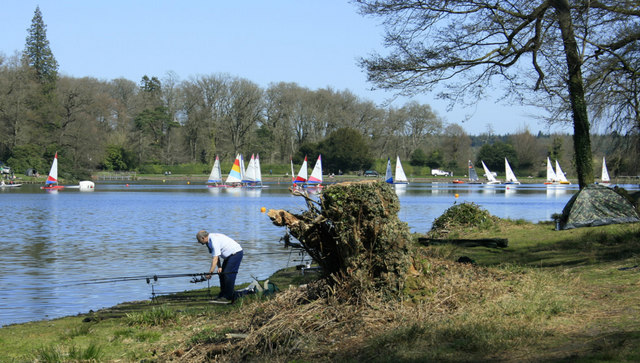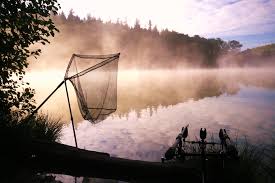
When we
fished at Gasper Lake, we became aware of a much bigger lake feeding into it.
We discovered that the lake belonged to the Shearwater Estate. We talked to
anglers along the bank and were told that they sold day tickets in the tackle
shop at Warminster or you could start fishing and the gamekeeper would sell you
a ticket on the bank.
Obviously, they had started doing what the Longleat
Estate had started and using the angling revenue to help the costs of the
upkeep of the estate. The lake itself was huge, being over half a mile in
length and several hundred yards wide at its widest. The lake was being used by
both anglers and the local yacht club and was a really great asset to the
community around Warminster. The only arguments that used to break out were
between the odd canoeist or windsurfer and the anglers who were trying to
ledger at long distance.

It could get a bit hairy at times, but I never
saw any serious stuff happen. Once each of the different fraternities learned
to respect and play together things weren’t too bad. The huge lake was
surrounded by dense forest and was very good for cyclists and walkers, who
enjoyed the environment. It made for a good walk on a Sunday after lunch, with
many walkers along the path.
They seemed
to enjoy watching the anglers and other water users. On misty damp days it took
on the appearance of pre-historic times and you might expect a monster from the
deep to surface in the middle of the lake at any time. It looked really
stunning, especially in the early mornings and late evenings when the sun rose
and set.





Sometimes,
it was a bit of a nuisance having person after person asking you “how you are
doing”, and “have you caught anything”. I did think about putting a little sign
up just behind me saying “No, I haven’t caught anything and I don’t want to
talk about it, so good day to you”. I chickened out though and just put up with
it. If you did catch fish it was not long before a crowd stood behind you and
started cheering every time you hooked into one.
This would
push the shoals further out and you would then have to cast further for your
bites. Never the less it was a pleasure to fish the stunning place. My friends
and I used to favour the dam wall when fishing there. The water was up to 14ft
deep along the wall and this made float fishing on the bottom quite difficult.
Fortunately, we found a method of catching in mid water at about 8 feet. The
lake itself tended to shallow up to about 8ft half way up to only 4 foot at the
top end of the lake.
On really warm summer days the tench and bream would move
up into this shallower water and good bags of 50 to 60lb of fish could be
caught.
As the
season moved towards Autumn, the deeper water on the dam wall really came into
its own. Shoals of big bream to 5lb patrolled the area and also good roach and
tench. The more lazy anglers would switch to the ledger for more easy fishing,
but once mastered the float was much better. When windy, the dam wall could not
be bettered because both sides of the lake except for the right corner bay
would get very choppy and a fierce undertow would make holding bottom with a
float just about impossible if you fished more than 20 feet out. The little bay
in the right corner, however, had a large lily pad area which served as a good
cover for fish and which was much calmer than the rest of the water which soon
became choppy. When windy it tended to
blow from behind you on the dam wall. This gave you fairly calm water in front
of you which made detecting bites much easier.

Some anglers
would swear by fishing on the bottom as the big bream were the target. Most
fished with sweet corn, maggots or casters.
On our first visit we decided to tackle the dam wall with sliding
floats. Expecting to catch fairly good sized bream as we had been told, we laid
a bed of ground bait laced with pinkies and casters. About 8 large handfuls
which were squeezed very tightly to hold together until it got to the lower
depths close to the bottom. We fished with two or three maggots on a size 16
hook.
What we found was that after a couple of
hours the bites got fewer and far between. We had 4 or 5 bream each to about
4lb in weight. The bites we did get had us striking thin area and we could not
make any contact with them. We tried putting more ground bait in but it made no
difference. We could not buy a fish. In desperation I decided to come up to
about half depth at 8 feet. Fishing on maggot I caught a few nice roach, but no
big bream. The only other option I could think of was to change bait, so I
tried various sizes of pieces of bread flake. My first bite came on a piece the
size of a 50 pence piece.
As I struck into a heavy fish I realised that
either the continual baiting had caused the bream to actually come up into the
higher layers or that they were seeking the warmer thermal layers to feed. It
was a bigger specimen around the 5lb mark.

I was
gobsmacked because I had to admit that I genuinely believed that bream where
bottom feeders only. That is what all the text books tell you, so catching them
in mid water went against all that. I had to accept the new evidence as
continued to catch bream after bream at mid-water levels. Imagine the scene
with passer’s by cheering every fish catch. Some of the non anglers had never
seen big fish like that being caught one after the other and quite a crowd
gathered behind us. It was like playing to a gallery, something I quite
enjoyed. Again we
suffered after that, the dam wall was taken up every time we went back.
It was quite
a race each time to claim swims as they only opened the gates at about 7.30am
and no one was allowed to fish before that time. The fishery also closed at
dusk and no night fishing was allowed. We had bags up to around 80lb each and I
have never experienced big bream fishing like that before or since. These days
bream go much bigger, but forty years ago they were big for that time. I heard
that a few years later they introduced a large head of carp at about 6 ounces
size.
The pole
began to be the method in deep water and the carp gradually took over from the
bream along the dam wall. They were mostly the fish you hooked when fishing
there after that. A bit of a pity, because that sort of fishing was too easy.
Saying that, those carp are probably double figures these days, but again, I am
not sure that I want to find out.
What size the bream go I couldn’t imagine. I
will continue to remember how it was in the seventies and early eighties
because the capture of illusive fish which fed in the mid-depths against all
known information of the time gave me far more satisfaction than the easy pole
fishing which took over.
No comments:
Post a Comment